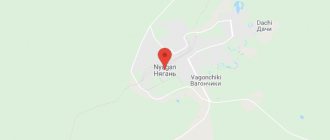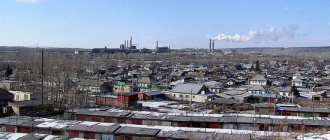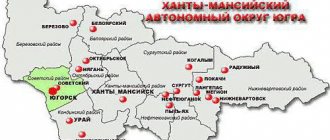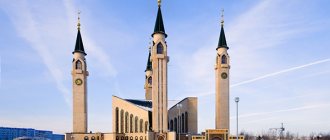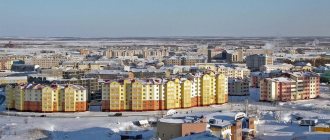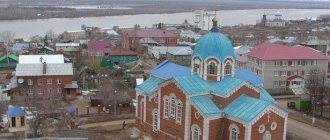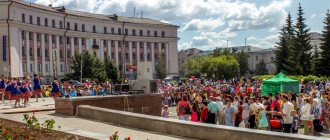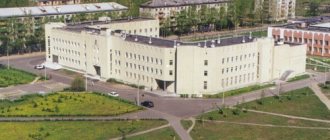Geographic information
The city was built at the mouth of the Megi River in the central part of the Middle Ob Lowland, not far from the Samotlor oil field. The average altitude of the territory above sea level is from 40 to 45 meters. The Saima River flows within the city limits, which is partially enclosed in a pipe.
In terms of natural and climatic conditions, the region is equated to the Far North with a sharply continental climate. Winters are long and very cold, summers are short and quite warm. The coldest month here is January with an average temperature of minus 17.8°C, the warmest month is July, plus 17.8°C. The absolute minimum was recorded in January 2006 and was minus 62°C. The average temperature for the year is minus 1.7 °C.
Main streets of Megion
A map of Megion with streets allows you to get the following information:
- Gubkin Street is a continuation of Transportnaya Street and turns into Yuzhnaya Street. In terms of length, this is one of the largest streets in Megion. Apart from numerous residential buildings, industrial premises and the Pearl swimming pool, nothing is located here.
- Svobody Street , running from Gubkin Street and flowing into Lenin Street, is located in the central part of the city. A map of Megion with houses shows that there are many residential buildings, as well as educational institutions (schools No. 1 and No. 9).
- Zapadnaya Street is located on the outskirts of the city, mainly among industrial premises and warehouses.
- Yuzhnaya Street , connecting Novaya and Gubkin streets, runs in the lower part of the city, parallel to the place where the Mega flows into the Ob. There is nothing noteworthy here except industrial premises.
- Novaya Street flows from Yuzhnaya Street and crosses Pobeda Avenue. There are residential buildings, several shops, the Old Cemetery, as well as one of the main attractions of the city - the Church of the Intercession.
- Lenin Street is located in the eastern part of the city, as if flowing from Svobody Street to Geologists Street. It runs parallel to the Mega channel, not far from its confluence with the Ob. Apart from residential buildings and commercial infrastructure, there is nothing noteworthy here.
general information
Megion in the Khanty-Mansi Autonomous Okrug of the same name, Ugra, is the administrative center. Together with the more famous city of Nizhnevartovsk, it acts as a center of oil production. Moreover, it was here that the first well of the largest Russian oil field, Samotlorsokoye, was drilled. The nearest city of Nizhnevartovsk is 28 km away, and the capital of the autonomous region is 500 km away. The population of Megion is 48 thousand people.
The main enterprise is OJSC Slavneft-Megionneftegaz, which accounts for about 45% of industrial production. The company is engaged in oil and gas production. In addition, there are enterprises for the repair and maintenance of machinery and equipment for the oil and gas industry, lumber production and the food industry.
The name of the city was given by the indigenous people who lived in this area. The 19th-century Hungarian linguist Bernat Munkacsi wrote: “In the Khanty language, the name of the Mayon yurts sounds like Mehe-Ung-Puhyl, which means “settlement at the mouth of a bend,” since “mehi” means a bend in the river, “puhyl” means a settlement, “ong” - mouth." Mayon is the original spelling in Russian, later they began to write “Mega”.
Sights of the city of Megion
The city has been a place of labor and industry throughout history, which has left its mark on its tourism potential. However, while staying in Megion, it is recommended to pay attention to the following attractions:
- Temple in honor of the Holy Martyr Grand Duchess Elizabeth.
- The Pioneer Monument, which consists of three people gathered around a golden dome.
- A square in honor of the extraction of the 500 millionth ton of oil.
- Church in honor of the Intercession of the Mother of God.
- The Monument to the Soldier-Liberator is a place of memory and sorrow for those who gave their lives during the Great Patriotic War. Another stele dedicated to the victims of the Chechen war was also installed here.
Early years
The first mention of the settlement dates back to 1781. The “List of Populated Places of the Siberian Territory” indicates 1810 as the time of the founding of the Mayon yurt. The “List of populated places according to information from 1868-1869” states that in the Ostyak Mayon yurts on the Ob River there are two courtyards with a population of 14 people and in the Megipulsky yurts on the Megi channel there are five courtyards with 31 inhabitants. In 1896-1897 the settlement is already listed as Russian with a population of Megion of 23 people.
In the directories of the Novosibirsk and Tomsk shipping companies and pilot maps there is information that at the dawn of the 20th century, the Magayon yurts served as so-called “exchange points” where you can exchange salt and matches for firewood. Such mutual trade brought significant income to the Russian and Ostyak populations. In 1912, the Magayon yurts had 5 courtyards and a zemstvo tract station. Local residents carried out transportation, fished, and hunted. Fish, furs, and game were handed over to the merchant Prolomkin Stepan Yakovlevich, who was the actual owner of these places.
Local history
Central Banking Station of Megion
Local history
History of the city of Megion
The city of Megion is located at the mouth of the Mega channel. The Hungarian linguist Bernat Munkacsi recorded at the end of the 19th century the Khanty name of the Megion yurts in the form Mekhe-Ung-Puhyl (Mekhi-Ong-Puhyl), which translated means “settlement at the mouth of the bend”, since “puhyl” is a settlement, “ong” – mouth, “bellows” – bend of the river.
The question of the time of Megion's emergence is quite complex. The Magionskie, Likrysov, Ermakov yurts have been mentioned since 1781. The article by V. Novokshonov indicates the year the Mayon yurt appeared - 1810. The author refers to the “Comprehensive survey and land management of the native, Russian, old-timer population of the Aleksandrovsky district of the Narym district of the West Siberian Territory, carried out in 1934." In 1810, as the time of the formation of the yurt, Mayon is indicated in the “List of populated places in the Siberian Territory.”
In the “List of populated places according to information from 1868-1869.” Ostyak yurts appear Mayonsky (Magionsky) near the river. Ob with two courtyards, with a population of 14 people, and the Ostyak Megipulsky yurts at the Mega channel with 5 courtyards and a population of 31 people.
In “Statistical information about the Ostyaks inhabiting the banks of the Ob within the Surgut district. In the space from the Narym border to the city of Surgut, according to data from 1896-1897, prepared by Dunin-Gorkavich in the south. Among the four farms in Magionsky there is already one Russian, the total number of residents is 23 people. They had 9 cows, 34 horses, 14 dogs.
Magayon yurts are listed in pilot maps and directories of the Tomsk and Novosibirsk shipping companies at the beginning of this century as a place where, in exchange for salt and matches, one could refuel with firewood. The sale of firewood to steamship owners brought significant profits to both the Russian and Ostyak populations.
According to official data published in the Tobolsk province in 1912, the territory of the Nizhnevartovsk region was part of the Laryak volost, numbering 46 settlements (yurts), and the Lokosovskaya volost of the Surgut district. 40 kilometers west of it, downstream the Ob, were the Magayon yurts with 5 courtyards and a zemstvo tract station. The Khanty willingly engaged in postal transportation. They kept many horses. Only Prolomkin had about 20. The mail was delivered on horses with bells so that it could be heard from afar. This mail was popularly called “string”. Her route ran from Nizhnevartovsk to Lokosovo through Megion and Vata and back, stopping only to feed and water the horses.
Near Magayonsky there were yurts Lekrysovo and Ermakovo. There was a legend about the latter that Ermak’s squad stopped here for a rest. All nearby yurts were inhabited by Khanty. The Magayon yurts were no exception. As old-timers recall, each Khanty family had two houses. In one they lived in the summer, under the mountain, and in the second in the winter, on the mountain. This is where it came from: the foothill part of the village and the mountainous part. Now these streets have the same names.
As researchers from the beginning of the century noted, near the Mayon yurts there were “thicket cedar forests” where nuts were peeled (at Mayon 4x6 versts, and at Vata - 5x10 versts).
Residents of Magayon yurts traditionally engaged in fishing. The catch was handed over to a local rich man, Stepan Yakovlevich Prolomkin. He was the master of these places. The Khanty gave him furs, upland game, and bear skins. He resold all this to Tyumen and Tobolsk merchants, with double and triple benefits. And he took goods from merchants.
In the 30s, with the beginning of complete collectivization, accompanied by dispossession, special settlers appeared here. From among them, fishing artels were created - the simplest associations of an agricultural nature, namely: in the south. Megion - “named after. Stakhanov" (1936), in the village. Mega – “Drummer” (1935), village Mega – “named after. Kalinin" (1935), in the village of Lekrysovo - "named after. Kuibyshev" (1935), in the village of Ermakovo - "named after. March 8 (1934). The economy of these agricultural cooperatives can be called complex, since they were engaged in fishing, hunting, procurement of pine nuts, berries, as well as field work. They grew winter rye, oats, barley, spring wheat, potatoes, fodder root crops, incl. In some farms, attempts were made to grow fiber flax and tobacco.
At the beginning of 1941 there was a big flood in our area. The village of Lekrysovo was almost completely flooded. People saved all their property as best they could, dismantled their houses and transported them to the high bank of the Megion channel. Before the houses had even been built, a commissioner from Nizhnevartovsk arrived on a barge and announced the beginning of the war.
The Great Patriotic War brought many trials. According to archival data, 30 people went to the front from the village of Mega, from the village. Mega 2 people from the village of Ermakovo - 10 people, from the village of Lekrysovo - 35 people. On collective farms, the active workforce was made up of women, who manually harvested tons of fish for the front. Thus, only one collective farm “Udarnik” (Mega village) gave the country more than 40 thousand centners of fish. Life during the war was hard and hungry. They gave 200 grams per day. of bread. All the fish were handed over, the fishermen were allocated only for food.
The authorized representatives strictly ensured that no one took fish from the fishery. Viktor Nikiforovich Vinokurov recalls that in the office there was a slogan: “Every shot is a blow to the enemy.” Few people know that the Megions sent smoked ducks to the front. During the spring hunting period, the production rate was 5 ducks per day.
The collective farm in the village of Mega was small - 30-40 working-age people. There were 200 heads of cattle, 10-15 sows, up to 200 sheep, 70-80 horses. The sown area was 30-40 hectares.
In February 1954, 4 collective farms: “Udarnik” (Mega village), named after. Kalinina (Mega Mysovaya), named after. Kuibyshev (Lekrysovo) and them. Stakhanov (Mega village) was united into one collective farm named after. Kalinin with its center in Megion, since it was located on the mainland of the Ob River - the main transport artery of Siberia at that time. At the meeting of collective farmers, the Charter of the united collective farm was adopted, the production plan was approved, and the collective farm board was elected. The chairman was V.N. Vinokurov. Gradually, people began to move to the economic center - Megion, and re-developed their household plots. This building has basically been preserved without any major changes on the street. Kolkhoz.
In 1959, on Bagras, one of the teams of the Surgut oil exploration expedition carried out test drilling in order to search for oil. March 21, 1961 from the Megionskaya-1 well, drilled by the team of master G.I. Norkin, the first gush of oil hit with a daily flow rate of 288 cubic meters per day.
On January 25, 1962, the Megion oil exploration expedition was organized, headed by V.A. Abazarov. According to him, “the expedition’s base was a canopy, under which stood a 50 kW power station and 1 pipe cutting machine. There were 280 people working on the expedition at that time.” . Since 1962 in the village. Megion began work on the construction site. Construction of houses is underway on the first streets of Megion - st. Sovetskaya and st. Lenin.
On June 5, 1964, the first barge with Megion oil set sail from oil gathering point No. 8 and headed up the Ob to Omsk. In total, during the 1964 navigation, 73.2 thousand tons of oil were shipped. In July 1964, the Megion exploration drilling office was organized in Nizhnevartovsk, and the first drillers arrived.
September 29, 1964 p. Megion receives the status of a workers' village.
In 1965, on the basis of the construction site of the Megionneft NPU, construction and installation department No. 5 was created. It ensures the construction of all oil pipelines and, first of all, Samotlor, carries out the construction of residential premises.
In 1972, the oil production production department of NPU Megionneft was divided into two departments: Megionneft and Nizhnevartovskneft. The first oil and gas production department was headed by the discoverer of oil in our area, V.A. Abazarov, later A.L. Reznikov.
July 23, 1980 By decree of the Presidium of the Supreme Soviet of the RSFSR, the workers' village of Megion was transformed into a city of district subordination.
By the Law of the Khanty-Mansiysk Autonomous Okrug - Ugra of November 25, 2004 No. 63-oz “On the status and boundaries of municipalities of the Khanty-Mansiysk Autonomous Okrug - Ugra” the city of Megion is endowed with the status of an urban district. The official name of the urban district is the city of Megion.
Coat of arms and flag
The symbols of the urban district of Megion are the coat of arms and flag
The coat of arms of a municipality is an identification and legal sign that corresponds to established traditions and is compiled according to the rules of heraldry, which is a symbol of city status, power and self-government. The coat of arms of the city of Megion was approved by the decision of the Duma of the municipal formation of the city of district significance of Megion dated July 19, 2001 No. 94, registered with the Heraldic Council under the President of the Russian Federation and entered into the State Heraldic Register of the Russian Federation under number 818. The heraldic description of the coat of arms of the municipal formation “city of Megion” reads : “In a silver field, a black sable sits and turns around, accompanied by green spruce trees extending lower on the sides and in the upper corners by three green small free rafters, connected into a rafter, tilted into a sling and facing away from the sable.” The text of the description and the image of the coat of arms are stored in the Administration of the municipality and are available for review to all interested parties.
The city flag is the official symbol of the municipality. Green cloth with a 2:3 ratio with a white upper corner at the shaft, occupying 1/4 of the cloth; in the upper white corner there is an image of a black sable sitting and turning away from the staff, the height of which is 1/2 the width of the panel. The flag of the city of Megion was approved by the decision of the City Duma of the municipal formation of the city of district significance of Megion dated July 19, 2001 No. 94, registered with the Heraldic Council under the President of the Russian Federation and entered into the state heraldic register of the Russian Federation under number 818.
The resident population as of 01/01/2012, according to preliminary data from the department of consolidated statistical works of Khanty-Mansiyskstat, is 55,763 people.
Industry
The main city-forming factor in the city of Megion is the oil industry. Most other enterprises complement and ensure its functioning. The presence and condition of social facilities, funds for their development, maintenance, employment, income level and social security are decisively determined by the state of the basic sector of the city’s economy - oil and gas production.
Education
The city has a developed network of preschool and general education institutions; additional education institutions make a great contribution to the development of the younger generation: art schools, children's art school, children's and youth sports schools. In the field of physical culture and sports, the policy of local governments is aimed at creating conditions for the development of mass and individual forms of physical education, health, sports work with all categories of the population and Olympic sports. The city's athletes perform well at competitions at all levels. The city has created a comprehensive system of medical and preventive institutions and social protection institutions.
In recent years, a lot has been invested in strengthening and modernizing the housing and communal services complex and engineering support facilities.
Today's Megion is a modern, well-maintained city, in which all conditions for life, work, study and recreation have been created, and which continues to dynamically develop, build and become more beautiful.
Literature
1. Velikopolsky S.D. Megion Marathon / S.D. Greater Poland. – Tyumen: Mandr-Ika, 2004. – 384 p. : ill. About the people who were at the origins of the discovery of Megion oil, who did a lot for the development of the city. There are about a thousand names in the book, among which is V.A. Abazarov, 1st Head of the MNRE, A.A. Simakov, chairman of the Megion village council (1972-1980), Yu.S. Yaroshenko - the first mayor of Megion (1980-1985), the famous dynasty of the Rudolf family and many others.
2. For the glory of the native city: [photo album] / [T.V. Yurgenson, A.V. Karaseva L.A. Askarova and others]; hands project E.D. Balesnaya; auto-comp. N.I. Gyngazov. – Nizhnevartovsk: Grand-Art, 2005. – 95 p. The book reflects the culture, identity and lifestyle of our city, its citizens, and presents achievements in production activities, art, sports, healthcare, education, etc.
3. Dunin-Gorkavich A.A. Tobolsk North. T. 2. Geographical and static-economic description of the country in individual geographical areas. – M.: Liberea, 1996. – 432 p. : ill.
4. City of Megion: [Almanac. Souvenir edition] / ed. V.A. Kalganov, S.D. Shalupov. – Nizhnevartovsk: Priobye, 2011. – 50 p. : ill. Historical information about Megion, brief information about enterprises, institutions, and memorable places of the city.
5. Kashina L.D. Megion Museum of Local Lore: exhibitions and collections / L.D. Kashin and V.I. Spodina. – St. Petersburg. : Ivan Fedorov, 2004. – 80 p. : ill. To the 25th anniversary of Megion being granted city status. The section “From Yurts to the City” tells about the history of Megion.
6. Kozlov V.N. A road a quarter of a century long: [Essays] / V.N. Kozlov. – Ekaterinburg: “Aelita”, 1997. – 206 p. To the 25th anniversary of OJSC “SU-920”.
7. Kozlov V.N. Megion inspiration: Essays and poems / V.N. Kozlov. – Ekaterinburg: Publishing house “SV-96”, 2002. – 272 p. Megion, despite its youth, has rich, unique and strong cultural traditions. The book is dedicated to Megion art schools, creative groups, etc. But, unfortunately, some layers of the city’s cultural life did not come to the attention of the author.
8. Kozlov V.N. Megions are us. In 2 books: K.1: Essays and poems / V.N. Kozlov. – Nizhnevartovsk, 1997. – 190 p. The book is dedicated to veterans of the Great Patriotic War, drafted from Megion, who came to Megion, as well as prisoners of concentration camps, survivors of the siege of Leningrad, now living in our city.
9. Kozlov V.N. Megions are us. In 2 books: Book. 2: Sketches, essays, poems / V.N. Kozlov. – Ekaterinburg: Central Ural Book Publishing House, 2000. – 344 p. : ill. The book presents the memories of home front workers, their relatives, fellow villagers and colleagues. Photographs and documents from the personal and family archives of residents of Megion, Nizhnevartovsk and the village of Vysokoy, as well as materials from the Nizhnevartovsk regional archive, the Megion Museum of Local Lore and the Veterans Council of the city of Megion were used.
10. Brief historical information about the city of Megion / Regional Historical, Cultural and Environmental Center; comp. V.N. Smirnova. – Megion, 2000. – 5 p.
11. Megion: into the future with confidence: photo album / ed. S. Gasina. – St. Petersburg. : Ivan Fedorov, 2001. – 123 p. : ill., photo. The first most complete publication about our city, its historical past and modernity. Articles and photographs tell about enterprises, institutions, and cultural life of Megion.
12. Megion. 30 years: [Information booklet]. – Megion: LLC “Liga”, 2010. – 22 p.: ill. The pages of the colorful booklet contain historical information about Megion and excerpts from the essays of schoolchildren in the city.
13. Megion: Pages of history / ed. IN AND. From behind. – Novosibirsk: Solaris, 2000. – 118 p. : ill. Mayon yurts, the village of Megion, a modern oil city... When writing the book, a large number of archival documents and memories of old-timers were used.
14. Megion artistic. Painting. Graphic arts. Decorative and applied arts: [catalog: dedicated to the 20th anniversary of the city] / resp. per issue A.F. Mukhametova. – Megion: Mega Oil, 2000. – 27 p.
15. Megions are people of high duty: In 2.book: Book 1 / ed. I.F. Obukhov; under general ed. IN AND. From behind. – St. Petersburg. : Ivan Fedorov, 2005. – 168 p. : ill.
The book is dedicated to veterans of the Great Patriotic War, drafted from Megion, who came to Megion, as well as prisoners of concentration camps, survivors of the siege of Leningrad, now living or who lived in our city.
16. Megions are people of high duty: In 2 books: Book 2. / auto-comp. L.D. Kashina, A.T. Nabokov. – Ekaterinburg: Basko, 2007. – 184 p. : ill. The second book presents memories of home front workers, their relatives, photographs and documents from personal and family archives.
17. We have stood the test of time: the Megion oil and gas exploration expedition is 40 years old. 1962-2002: [photo album] / author. text by N. Kupaltsev and V. Kalganov. – St. Petersburg. : Ivan Fedorov, 2002. – 47 p.
OJSC Slavneft-Megionneftegazgeologiya is one of the largest geological enterprises that were the first to conduct exploration drilling for oil and gas in the Middle Ob region in the 50-60s. Today, OJSC Slavneft-Megionneftegazgeologiya is a service company that works under contracts with oil companies, fulfilling their orders for prospecting and exploration work using three expeditions - Megion, Vakh and Baykit. The largest of the three expeditions and the strongest in terms of personnel is Megion, which turns 40 in January 2002.
18. Oil and gas of Tyumen in documents: 1901-1965 / resp. ed. YES. Smorodinkov. – Ekaterinburg: Central Ural Book Publishing House, 1971. – 478 p.
19. Nizhnevartovsk district. Pages of history / ed. R.H. Kaibysheva. – Nizhnevartovsk: “Priobie”, 1998. – 207 p.
20. Ovsyannikov-Zayarsky V.P. From the depths of the strata of Siberia: 500,000,000 tons / V.P. Ovsyannikov-Zayarsky. – Ekaterinburg: Wed. - Ural. book publishing house, 2002. – 384 p. : ill. A book about the forty-year history of OJSC Slavneft-Megionneftegaz - the firstborn of the oil industry in Western Siberia, about how the initially small oil field management Megionneft grew into the largest joint-stock company, as well as about the people who not only laid the foundations of oil production and developed fields in the Middle Priobye, but also erected the modern city of Megion.
21. Under the northern sky: dedicated to the 20th anniversary of the city of Megion / author.-comp. S.A. Lutsky. – Nizhnevartovsk: MV-Print, 2000. – 234 p. Poems and prose by Megion authors, including V.N. Kozlov, E. Gosteva, T. Jurgenson, L.P. Taktasheva, A. Yusubova, recognized and known outside of Megion. The works of young poets (A. Suntsov, O. Abramovskaya-Velichko, and many others) are presented on the pages of the collection.
22. Rynkova I.I. Confession of the “iron” Bati: Memoirs / I.I. Rynkova. – Langepas: Press-Inform TV, 2004. – 94 p.: ill. The author of the book is an Honorary Oilman of Russia, an Honorary Resident of Nizhnevartovsk and Megion, one of the first leaders of the NPU Megionneft, the discoverer of Samotlor.
23. Birth certificate. Urai, Nefteyugansk. Labytnangi, Novy Urengoy, Megion, Noyabrsk: [Essays] / comp. R.S. Goldberg. – Sverdlovsk: Middle-Ural. book publishing house, 1988. – 208 p. : ill. – (Cities of our region). A book about young cities of the Tyumen region. The essay “A Sharp Turn” by Yu. Perepletkin is dedicated to Megion of the 60-70s - early. 80s last century, when Megion oil was discovered, when the city was being formed and enterprises and organizations were created one after another. In the essay we will see the names of people who have done a lot for the development of the city - Yu.S. Yaroshenko, chairman of the Megion city executive committee, pioneer geologists G.I. Norkin, V.A. Abazarov and others.
24. 40 years of Megion oil. 1964-2004: [photo album] / auto.-comp. G.F. Doroshenko, V.N. Kozlov, A. Kedrova and others - St. Petersburg. : Ivan Fedorov, 2004. – 103 p. In June 1964, the first barge with industrial oil was sent from Megion. Following this event, the first oil field appeared, on the basis of which the Megionneft oil production enterprise was created on August 1, and on September 29, 1964, Megion was given the status of a workers' village. This book is dedicated to the people involved in these events, as well as industrial, cultural, sports achievements, successes in education, and healthcare.
25. Spodina V.I. Megion. People and destinies / V.I. Spodina. – Nizhnevartovsk: Priobye, 1995. – 110 p. : ill. The history of Megion, archival documents, memories of old-timers, which over time acquire even greater significance and value - all this in one book.
26. Shlyabin D.D. At a sharp turn of the river: historical and publicist. essays / MU “Regional Historical, Cultural and Environmental Center”; D.D. Shlyabin. – Megion: Fast-Print LLC, 2004. – 48 p. : ill. The collection includes essays about the past of Megion, such as “The Golden Age of the Village of Megion”, “Where the Steamships Go”, “The Smell of Oil”. The book is addressed to those who are not indifferent to the history of their hometown, who are concerned about environmental problems and the beauty of nature.
Soviet period
After the start of collectivization and the dispossession campaign, special settlers were sent to these remote Siberian corners. In 1936, a fishing artel named after them was created from them in the Megion yurt. Stakhanov. Members of the association not only fished, but also collected nuts and berries. Rye, oats, barley, wheat, and potatoes were also grown.
During the war, most men were mobilized to the front, women were engaged in collecting fish for the soldiers. The collective farm in the village was very small: 30-40 workers, 200 heads of cattle, 70-80 horses, about 200 sheep, 10-15 pigs, 30-40 hectares of cultivated land. In 1954, several collective farms were merged into one, and people gradually moved to the administrative center of Megion. Land plots began to be developed; these houses have survived to this day on the street. Kolkhoz. By 1959, Megion's population reached 400 people.
City of oil and gas workers
In 1959, exploratory drilling began in the region in search of oil deposits. In 1961, the first hydrocarbon fountain came from the Megionskaya-1 well. The following year, a resource exploration enterprise was organized in the village - the Megion oil exploration expedition. Residential buildings began to be built for oil workers who came from all regions of the country. In 1964, oil began to be shipped, which was transported by barges to Novosibirsk. In the same year, the village received the status of a workers' village. In 1970, Megion's population was 6,431. In 1972, the Nizhnevartovskneft management was separated from the oil production enterprise NPU Megionneft.
Oil production grew rapidly, the village was improved. By 1979, 23,629 people already lived here. In 1980 the village received city status. According to the last Soviet census, the population of Megion was 39,783 people. The number of residents continued to increase mainly due to migration flow. In subsequent years until 2010, the population increased slightly, mostly due to natural growth. Since 2011, there have been slight fluctuations in this regard. At different periods, the population dynamics of the city of Megion manifested itself as both positive and negative.
Routes on the map of Megion. Transport infrastructure
The city's transport system is properly developed. A satellite map of Megion shows that a section of the federal highway 1R-404 “Khanty-Mansiysk - Tyumen” .
The city's railway service is represented by a station located in the urban-type settlement of Vysoky. However, the volume of railway use is minimal - most often it is freight trains. Trains pass through the station to Penza, Nizhnevartovsk, Ufa, Moscow, Adler, Volgograd and Astrakhan.
Public transport is organized within the city, covering all microdistricts. However, in recent years, due to an increase in the number of private cars and a decrease in interest in public transport, there has been a downward trend in passenger turnover.
Nizhnevartovsk airport is located 30 kilometers away.
